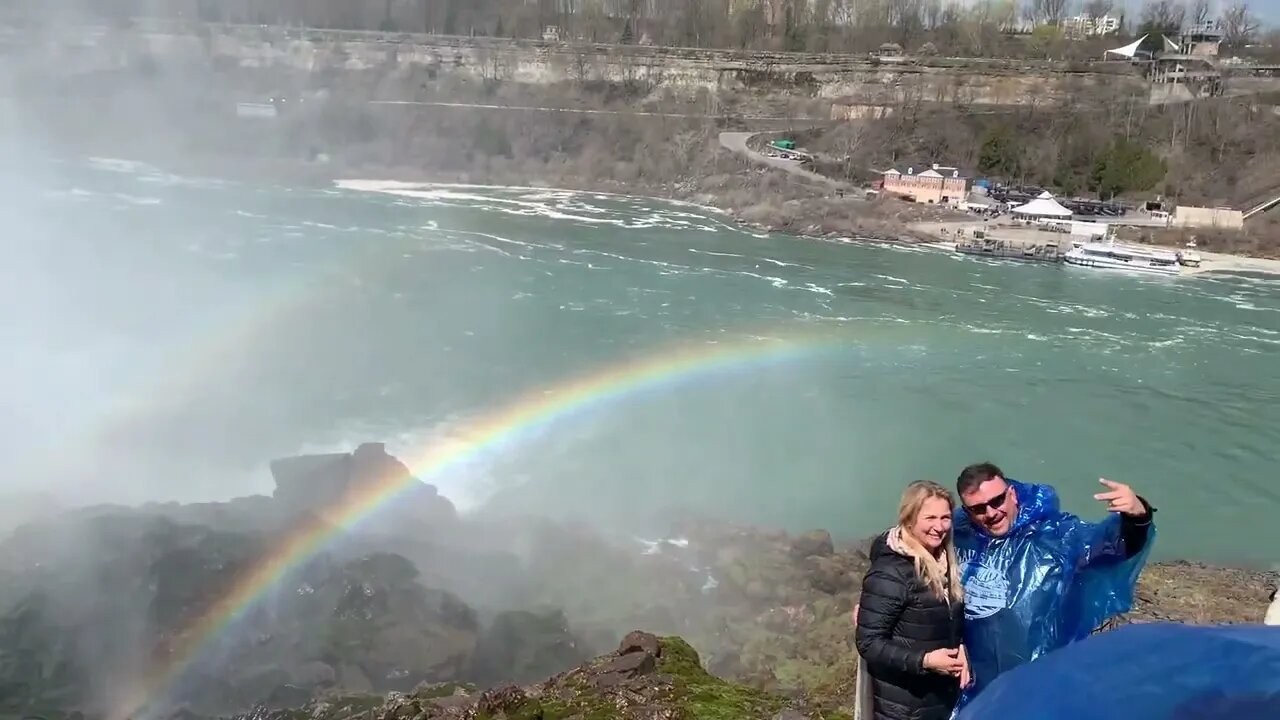Premium Only Content

NIAGARA FALLS, One Of The World's Most Beautiful Wonders, Up Close And Personal #shorts
Here's a short clip we took while we were right up close to one of the most famous and awe inspiring natural wonders, NIAGARA FALLS! This video was taken from the US side, and you can find out more about this beautiful location by visiting:
https://www.niagarafallsstatepark.com/
Don’t forget to check out Inspiring How UC That on our other platforms:
Website Links: www.ihuct.org
www.inspiringhowucthat.org
Facebook: https://www.facebook.com/inspiringhowUCthat
Instagram: https://www.instagram.com/inspiringhowucthat/
Twitter: https://twitter.com/IHUCT
Tiktok: https://www.tiktok.com/@ihuct
E-mail: inspiringhowucthat@gmail.com
As always, if you like this video, please give us a thumbs up and click Subscribe and the notification bell to keep up with our Artists Spotlights, Interviews, and other fun videos. Love you all! God bless!
#niagarafalls #niagarariver #amazingparks #number1parks #parkstovisi#funatthepark #parks #explore #coolplaces #fyp #inspiringhowucthat #wondersoftheworld #upclose
Biographical information on Niagara Falls from Wikipedia (https://en.wikipedia.org/wiki/Niagara_Falls):
Niagara Falls (/naɪˈæɡərə/) is a group of three waterfalls at the southern end of Niagara Gorge, spanning the border between the province of Ontario in Canada and the state of New York in the United States. The largest of the three is Horseshoe Falls, which straddles the international border of the two countries. It is also known as the Canadian Falls. The smaller American Falls and Bridal Veil Falls lie within the United States. Bridal Veil Falls is separated from Horseshoe Falls by Goat Island and from American Falls by Luna Island, with both islands situated in New York.
Formed by the Niagara River, which drains Lake Erie into Lake Ontario, the combined falls have the highest flow rate of any waterfall in North America that has a vertical drop of more than 50 m (160 ft). During peak daytime tourist hours, more than 168,000 m3 (5.9 million cu ft) of water goes over the crest of the falls every minute. Horseshoe Falls is the most powerful waterfall in North America, as measured by flow rate. Niagara Falls is famed for its beauty and is a valuable source of hydroelectric power. Balancing recreational, commercial, and industrial uses has been a challenge for the stewards of the falls since the 19th century.
Niagara Falls is 27 km (17 mi) northwest of Buffalo, New York, and 69 km (43 mi) southeast of Toronto, between the twin cities of Niagara Falls, Ontario, and Niagara Falls, New York. Niagara Falls was formed when glaciers receded at the end of the Wisconsin glaciation (the last ice age), and water from the newly formed Great Lakes carved a path over and through the Niagara Escarpment en route to the Atlantic Ocean.
Characteristics
Canadian Horseshoe Falls at right
Horseshoe Falls is about 57 m (187 ft) high, while the height of the American Falls varies between 21 and 30 m (69 and 98 ft) because of the presence of giant boulders at its base. The larger Horseshoe Falls is about 790 m (2,590 ft) wide, while the American Falls is 320 m (1,050 ft) wide. The distance between the American extremity of Niagara Falls and the Canadian extremity is 1,039 m (3,409 ft).
The peak flow over Horseshoe Falls was recorded at 6,400 m3 (230,000 cu ft) per second. The average annual flow rate is 2,400 m3 (85,000 cu ft) per second. Since the flow is a direct function of the Lake Erie water elevation, it typically peaks in late spring or early summer. During the summer months, at least 2,800 m3 (99,000 cu ft) per second of water traverse the falls, some 90% of which goes over Horseshoe Falls, while the balance is diverted to hydroelectric facilities and then on to American Falls and Bridal Veil Falls. This is accomplished by employing a weir – the International Control Dam – with movable gates upstream from Horseshoe Falls.
American Falls (large waterfall center-left) and Bridal Veil Falls (right)
The water flow is halved at night and during the low tourist season winter months and only attains a minimum flow of 1,400 cubic metres (49,000 cu ft) per second. Water diversion is regulated by the 1950 Niagara Treaty and is administered by the International Niagara Board of Control. The verdant green color of the water flowing over Niagara Falls is a byproduct of the estimated 60 tonnes/minute of dissolved salts and rock flour (very finely ground rock) generated by the erosive force of the Niagara River.
*Copyright Disclaimer Under Section 107 of the Copyright Act 1976, allowance is made for "fair use" for purposes such as criticism, comment, news reporting, teaching, scholarship, and research. Fair use is a use permitted by copyright statute that might otherwise be infringing. Non-profit, educational or personal use tips the balance in favor of fair use. No copyright infringement intended. ALL RIGHTS BELONG TO THEIR RESPECTIVE OWNERS*
-
 6:34:50
6:34:50
SpartakusLIVE
9 hours ago#1 Saturday Spartoons on RUMBLE PREMIUM
106K7 -
 1:04:59
1:04:59
Man in America
10 hours ago“Summoning the Demon” — The AI Agenda Is FAR WORSE Than We Know w/ Kay Rubacek
41.2K24 -
 2:16:48
2:16:48
Tundra Tactical
8 hours ago $0.08 earned🎯💥 The World’s Okayest Gun Show 🔫😂 | LIVE Tonight on Rumble!
23.9K -
 3:36:03
3:36:03
Mally_Mouse
1 day ago🌶️ 🥵Spicy BITE Saturday!! 🥵🌶️- Let's Play: Tower Unite!
49.1K2 -
 58:59
58:59
MattMorseTV
8 hours ago $1.29 earned🔴Trump just BROKE Newsom.🔴
64.3K80 -
 18:14
18:14
Her Patriot Voice
8 hours agoWho Is WORSE for NYC: Trump Girl or Socialist?
45.8K33 -
 3:39:42
3:39:42
SavageJayGatsby
8 hours agoSpicy Saturday with Mally! | Road to 100 | $300 Weekly Goal for Spicy Bites!
45.7K1 -
 3:35:50
3:35:50
FomoTV
10 hours ago🚨 Swamp Theater: FBI Raids Bolton 🕵 Still NO Epstein Files, Trump's Troops & the Red Heifer Hoax 🐂 | Fomocast 08.23.25
20.3K7 -
 6:04:40
6:04:40
Akademiks
13 hours agoRoc Nation & Meg Thee Stallion did a 7 HOUR Deposition with me. Drake Secret Kid Finally Revealed.
57.2K2 -
 24:19
24:19
Stephen Gardner
9 hours ago🚨BREAKING: FBI Raid of John Bolton’s House Reveals THIS!
59.4K142